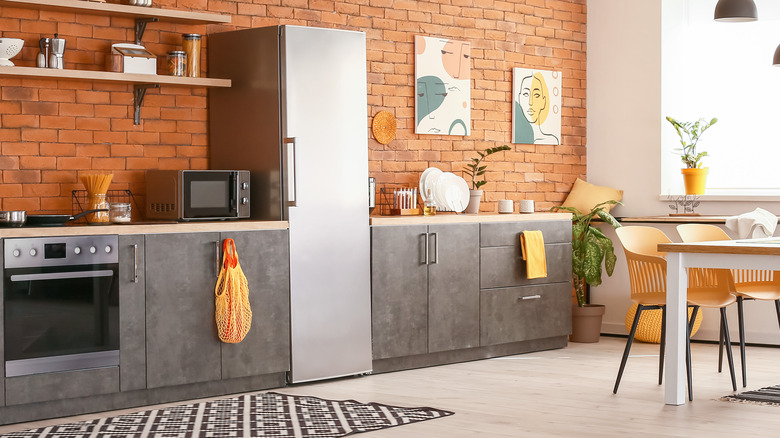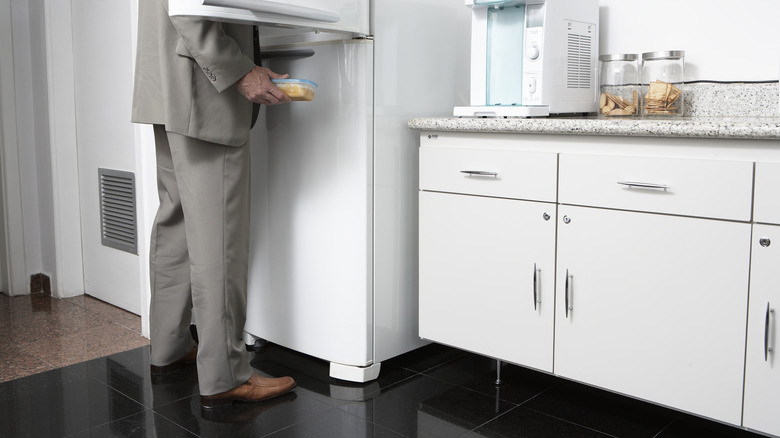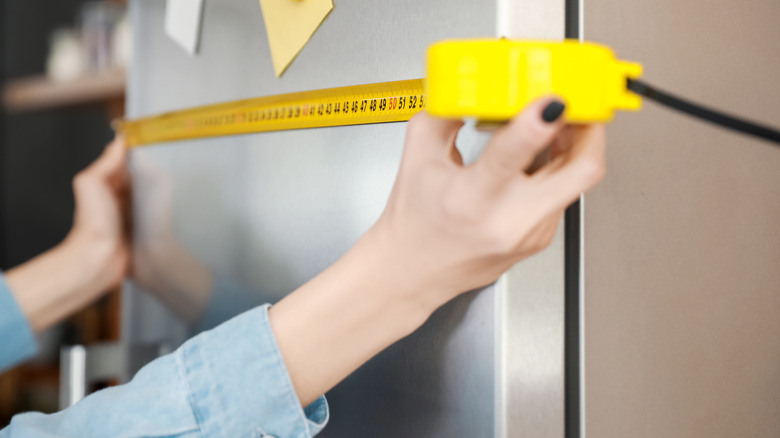What's A Counter-Depth Refrigerator And How To Determine The Right Dimensions
In most standard home kitchens, countertops project out from the wall by about 25 inches or more. Because most standard refrigerators are deeper than this, roughly 30 inches or more, the front of the fridge will stand out further than the counter's edge. Sometimes, the fridge can stick out from the counter by as much as 6 inches. If you're going for a modern, streamlined look in your kitchen, this depth discrepancy can be visually clunky and make your kitchen look cheap. Instead, you need to invest in a counter-depth refrigerator. A counter-depth refrigerator is slightly shallower than a standard model, allowing the edge of the countertop to align closely with the front of the fridge.
A good rule of thumb is to line up your countertop edge with the hinges on the fridge door, rather than the face of the door itself, and still have some room behind the fridge or airflow. But how do you ensure a perfect fit with your counter-depth refrigerator? And won't a shallower fridge mean less space for food? Here's everything you need to know about counter-depth refrigerators and measuring them to fit perfectly in your space.
The pros and cons of a counter-depth fridge
Counter-depth fridges may look slim and sleek, but, as you might expect, this streamlined profile creates a few practical downsides. Most notably, a counter-depth fridge won't have as much interior space as a standard full-size fridge. While the total standard fridge capacity is about 20 to 30 cubic feet, a counter-depth fridge averages between 15 to 25 cubic feet. A counter-depth fridge may come with a freezer compartment or not, but opting to have a freezer often means even wider dimensions and less fridge space. Shelves and drawers in a counter-depth fridge are also shallower than usual, but this makes it easier to reach for items at the back and organize your fridge in an appealing way.
To make up for the loss in internal space, counter-depth refrigerators are usually taller or wider than their full-size counterparts, so you'll need to take these measurements into account to ensure a good fit in your kitchen. Because the door of the fridge is wider, you'll need more clearance to open it (i.e., not bumping into an island). The change from a standard fridge to a counter-depth fridge might seem drastic initially, but most people adapt to a counter-depth fridge and have no trouble. If you live alone or with a roommate or partner, a counter-depth fridge should serve just fine. However, if you have a particularly large or hungry family, a standard-size fridge is better to keep food stocked.
How to measure for your fridge
The main purpose of a counter-depth fridge is to achieve that built-in, streamlined look, so neglecting to measure your space can be one of the worst mistakes when buying a refrigerator. Before bringing a counter-depth fridge home, you'll need to measure the place where you want it very carefully. Most kitchens are built with a fridge compartment or cabinet cutout. If you're swapping out your standard fridge, you'll need to be sure that the cutout has room to accommodate the extra width and height of a counter-depth fridge. Fridges also need some wiggle room for ventilation, so account for at least an inch of space on the back and 1/4 to 1/2 an inch on the sides.
First, determine the depth of your counters by measuring from the backsplash or wall to the very edge of the countertop overhang. Most countertops are around 25 inches deep, but yours may vary. Your fridge will need to be deep enough to allow the door to swing open without bumping into the counter's edge, so counter-depth fridges may still stand out about 2 inches from the counter. Once you've determined the fridge depth you need, measure the space for the fridge width and height, and remember to subtract some space on all sides for breathing room.


